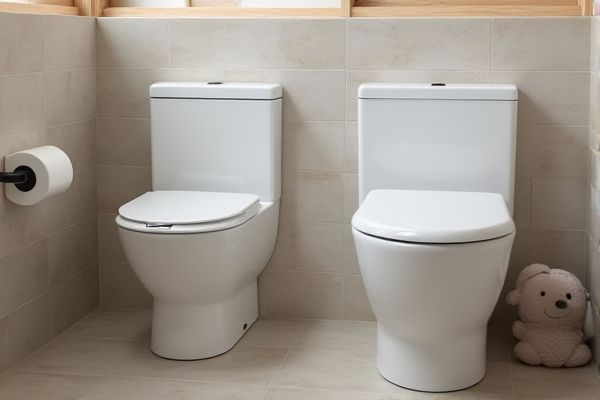
Manual flush systems require physical activation, offering control and simplicity, while automatic flush technology enhances hygiene and convenience by using sensors for touchless operation. Explore the article to discover which flush option best suits your needs and lifestyle.
Table of Comparison
| Feature | Manual Flush | Automatic Flush |
|---|---|---|
| Activation Method | User-operated lever or button | Sensor-based detection (infrared, motion) |
| Hygiene | Requires contact, potential germ spread | Touchless, reduces germ transmission |
| Water Efficiency | Depends on user judgment, may waste water | Preset volumes, optimized for conservation |
| Installation Cost | Lower initial cost | Higher due to sensors and electronics |
| Maintenance | Simple, fewer problems | Requires regular sensor and battery checks |
| Reliability | Consistent, manual control | Can malfunction or delay due to sensor issues |
| Energy Use | No energy consumption | Uses batteries or electrical power |
Introduction to Manual vs Automatic Flush Systems
Manual flush systems require users to physically activate a handle or button to initiate water flow, offering straightforward operation and reliable performance. Automatic flush systems use sensors to detect user presence and trigger flushes without contact, enhancing hygiene and reducing water waste. Both systems serve essential roles in restrooms, but automatic flushes are increasingly preferred in public and high-traffic facilities for their convenience and sanitation benefits.
How Manual Flush Toilets Work
Manual flush toilets operate by using a lever or button that activates a mechanism to release water from the tank into the bowl, flushing waste away. When the handle is pressed, it lifts a flapper or valve inside the tank, allowing gravity to push water through the rim holes and siphon the contents. This simple mechanical process requires no electricity and relies on human intervention to initiate each flush.
How Automatic Flush Toilets Function
Automatic flush toilets use sensors to detect when a user has finished, activating the flush without manual effort. Infrared or motion sensors trigger the flushing mechanism, ensuring hygienic operation and water efficiency. You benefit from reduced contact with surfaces, enhancing cleanliness and convenience in restrooms.
Hygiene Comparison: Manual vs Automatic Flush
Automatic flush systems significantly reduce the spread of germs by eliminating the need for physical contact, enhancing overall restroom hygiene. Manual flush mechanisms require touching handles or buttons, increasing the risk of transferring bacteria and viruses, especially in high-traffic areas. Your choice between manual and automatic flush impacts hygiene levels, with automatic flushes offering a more sanitary solution to minimize contamination.
Water Efficiency and Conservation: Which Is Better?
Automatic flush toilets use sensors to optimize water usage by flushing only when necessary, significantly reducing water waste compared to manual flush systems that rely on users to determine flush duration. Studies show automatic flush toilets can reduce water consumption by up to 30%, contributing to better water efficiency and conservation in public and commercial restrooms. Manual flush toilets often lead to over-flushing and inefficiencies, making automatic flush systems the preferred choice for sustainable water management.
Maintenance and Durability: Pros and Cons
Manual flush systems require minimal maintenance due to their simple mechanical components but are more prone to wear and frequent repairs from user handling. Automatic flush systems offer enhanced durability with fewer mechanical parts exposed to manual operation, reducing maintenance frequency, yet they may incur higher repair costs due to sensor malfunctions or electrical issues. Both systems demand regular inspections to ensure optimal functionality, with manual flushes benefiting from ease of maintenance and automatic flushes excelling in hygiene and long-term durability under high-traffic conditions.
Installation Costs and Long-Term Investment
Manual flush toilets generally feature lower installation costs due to simpler mechanisms and reduced plumbing requirements. Automatic flush systems, while more expensive upfront because of electronic components and sensor integration, offer long-term investment benefits by promoting water efficiency and reducing maintenance needs. Choosing between the two depends on prioritizing initial budget constraints versus potential operational savings over time.
User Experience and Accessibility
Automatic flush systems enhance user experience by providing hands-free operation, reducing contact with germs and promoting hygiene in public restrooms. Manual flush mechanisms offer tactile feedback and simplicity, which can be preferable for individuals with certain disabilities or those who find sensor technology unreliable. Accessibility considerations emphasize that both systems should accommodate varying physical abilities, ensuring ease of use and compliance with ADA standards.
Common Issues and Troubleshooting
Manual flush toilets often face problems like handle stiffness, chain detachment, or water leakage due to worn-out flapper valves, requiring simple repairs such as adjusting the chain length or replacing faulty parts. Automatic flush systems may experience sensor malfunctions, weak flush power, or battery failures, typically resolved by cleaning sensor lenses, checking power sources, or recalibrating sensor sensitivity. Understanding specific issues related to both systems allows for accurate troubleshooting and maintaining optimal toilet performance.
Which Flush System Is Right for You?
Manual flush systems offer precise control and typically use less water per flush, making them ideal for users prioritizing water conservation and cost savings. Automatic flush systems provide hands-free convenience and enhanced hygiene, reducing the spread of germs in high-traffic or public restrooms. Your choice depends on whether you value water efficiency and control or the convenience and cleanliness of touchless operation.
 homyna.com
homyna.com